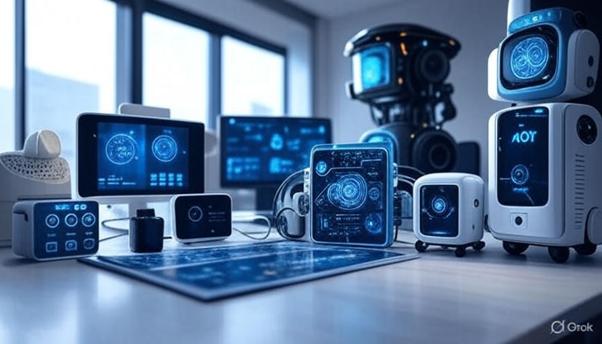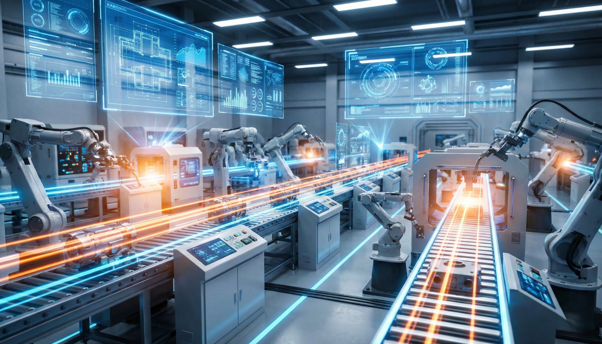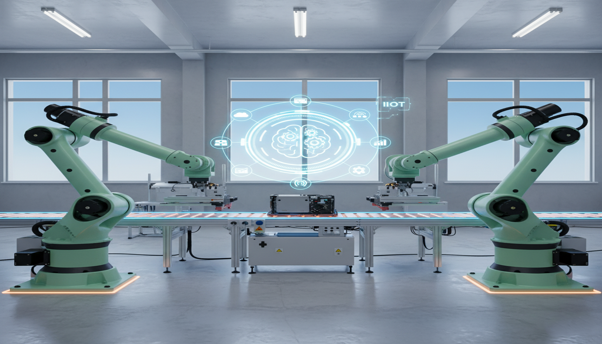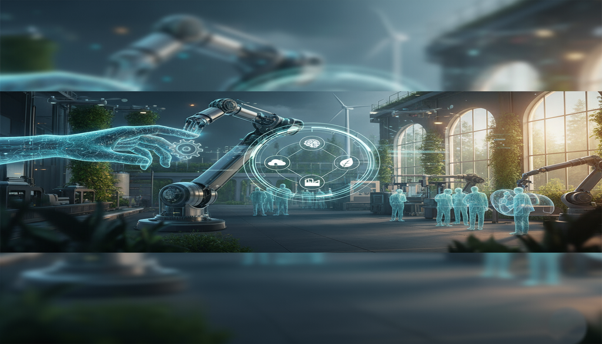The Power of Connectivity and Analytics
In today’s rapidly evolving technological landscape, the Internet of Things (IoT) and Analytics of Things (AoT) are transforming industries by combining connectivity with intelligent data analysis. Businesses are no longer just collecting data; they are harnessing it to make smarter decisions and drive innovation. At INGSOL, we specialize in delivering cutting-edge solutions that integrate IoT and AoT, enabling companies to automate processes, gain real-time insights, and achieve operational excellence. This blog explores the key differences between IoT and AoT, their roles, synergy, applications, benefits, challenges, and emerging trends, giving you a clear roadmap to leveraging these technologies for your business.

Understanding the Basics

The foundation of modern connectivity lies in IoT ,a vast network of physical devices embedded with sensors, software, and network capabilities that collect and exchange data over the internet. These “things” range from wearable fitness trackers and smart thermostats to advanced industrial machinery. They allow businesses to monitor systems in real time, track performance, and automate processes, resulting in increased efficiency and reduced costs.
AoT, on the other hand, represents the intelligence behind these devices. It refers to the analytical layer that processes IoT-generated data, transforming it into actionable insights through advanced analytics, machine learning, and artificial intelligence. While IoT focuses on capturing and sharing data, AoT emphasizes interpreting and leveraging that data to optimize decisions and improve outcomes. For example, while IoT sensors can measure temperature in a warehouse, AoT can analyze that data to predict maintenance needs, reduce energy consumption, or identify operational bottlenecks.
At INGSOL, we view IoT as the infrastructure that gathers real-world intelligence, while AoT is the brain that extracts strategic value, turning raw data into business intelligence that drives growth.
Core Definitions and Their Roles

IoT (Internet of Things): IoT forms the backbone of data acquisition, creating an interconnected ecosystem where devices like sensors in homes, factories, or healthcare facilities collect and share information. Its primary role includes enabling remote monitoring, automation, predictive maintenance, and efficient resource management. It serves as the digital nervous system of modern organizations, allowing data to flow seamlessly between devices and platforms.
AoT (Analytics of Things): AoT builds on this foundation by applying data analytics, algorithms, and AI to interpret IoT data. Its role is to provide context, detect patterns, predict outcomes, and drive informed decisions. For example, by analyzing sensor data, AoT can predict equipment failures, reduce downtime, and improve operational efficiency. AoT also plays a vital role in uncovering hidden trends, improving customer experiences, and identifying new revenue streams.
At INGSOL, we integrate these technologies into tailored solutions that maximize data-driven results and scalability. Our solutions are designed to ensure seamless data flow and actionable outcomes that directly impact the bottom line.
How IoT and AoT Interrelate

The relationship between IoT (Internet of Things) and AoT (Analytics of Things) is not just complementary, it’s symbiotic. IoT provides the raw material in the form of data, while AoT acts as the intelligence layer that extracts meaning, patterns, and actionable strategies from this information. Without IoT, AoT would lack a data source; without AoT, IoT data would remain underutilized and overwhelming. Together, they create a closed-loop ecosystem where continuous improvement, automation, and optimization thrive.
The Feedback Loop of IoT and AoT
- IoT as the “senses”: Connected devices, ranging from smart sensors in machines to GPS trackers on logistics fleets, constantly collect real-time data such as temperature, location, performance, or usage.
- AoT as the “brain”: This collected data is processed using analytics, machine learning, and AI algorithms to identify trends, predict issues, and recommend decisions.
- The cycle of optimization: Insights from AoT are then fed back into IoT systems to fine-tune operations, creating a self-improving loop of efficiency.
Real-World Applications of IoT-AoT Synergy
- Smart Supply Chains
- IoT’s Role: Sensors monitor inventory levels, shipment conditions (like humidity or temperature), and delivery timelines in real time.
- AoT’s Role: Data is analyzed to forecast stock shortages, optimize delivery routes, and automate procurement decisions.
- Business Value: Reduced stock-outs, optimized logistics, and enhanced customer satisfaction.
- Predictive Manufacturing
- IoT’s Role: Machines are embedded with vibration, heat, and performance sensors that detect abnormalities.
- AoT’s Role: Predictive algorithms analyze this data to forecast equipment breakdowns before they occur and adjust production schedules accordingly.
- Business Value: Reduced downtime, extended machine life, and significant cost savings.
- Smart Cities
- IoT’s Role: Devices track traffic flow, pollution levels, and energy usage.
- AoT’s Role: Insights enable optimized traffic light management, predictive maintenance of public infrastructure, and improved energy distribution.
- Business Value: More sustainable, efficient, and livable urban environments.
- Healthcare
- IoT’s Role: Wearable devices track patient vitals like heart rate, blood pressure, and glucose levels in real time.
- AoT’s Role: Data is analyzed to detect anomalies, predict medical emergencies, and personalize treatment plans.
- Business Value: Preventive healthcare, faster response times, and improved patient outcomes.
Why This Synergy Matters for Businesses
At INGSOL, we view IoT and AoT as inseparable pillars of digital transformation. Businesses that adopt IoT-only systems may gather massive amounts of data but often face “data overload” without clarity. On the other hand, AoT ensures this data translates into strategic decision-making, cost savings, and innovation.
By integrating IoT with AoT, organizations unlock:
- Efficiency gains through real-time process optimization.
- Resilience by predicting risks and mitigating them before impact.
- Competitive advantage by using data-driven intelligence to innovate faster than competitors.
In short, IoT powers connectivity, and AoT powers intelligence—together, they form the backbone of a smarter, more agile enterprise.
Applications and Use Cases

Smart Homes:
IoT powers devices like thermostats, lights, and security systems, collecting data on user behavior and environmental conditions. AoT turns this data into actionable insights, such as energy optimization recommendations, predictive alerts for device failures, or enhanced security monitoring.Industrial Automation:
IoT sensors monitor equipment performance, environmental factors, and production lines. AoT predicts failures, optimizes maintenance schedules, and ensures consistent product quality. This leads to reduced downtime and significant cost savings.Healthcare:
IoT-enabled medical devices track patients’ vitals, including heart rate, blood pressure, and oxygen levels. AoT processes this data to support early diagnosis, personalized care, and proactive interventions, improving patient outcomes and reducing hospital readmissions.Smart Cities:
IoT infrastructure manages traffic lights, waste collection, energy grids, and public safety systems. AoT enables city planners to analyze trends, optimize resources, reduce pollution, and improve overall quality of life.
At INGSOL, we have implemented AoT solutions that analyze IoT data from energy grids to enhance sustainability and efficiency, helping businesses and governments meet their environmental goals.
Benefits for Businesses

IoT Advantages:
- Improved operational efficiency and automation, reducing manual intervention.
- Enhanced real-time visibility into assets, inventory, and processes.
- Faster and more accurate decision-making with data-driven insights.
- Cost savings through predictive maintenance and energy optimization.
AoT Advantages:
- Unlocks deeper insights from existing data.
- Predictive analytics helps anticipate failures and mitigate risks.
- Improves customer experiences with personalized recommendations and services.
- Strengthens business intelligence, enabling innovation and strategic growth.
For INGSOL clients, combining IoT and AoT translates into measurable ROI, innovation, and sustainable competitive edge, ensuring they remain future-ready in an increasingly connected world.
Challenges and the Case for Standards

While the combination of IoT and AoT promises transformative value, the path to widespread adoption is not without obstacles. Many organizations struggle to harness the full potential of these technologies due to fragmented ecosystems, security vulnerabilities, and the lack of universal standards. Addressing these challenges is essential for building systems that are scalable, trustworthy, and future-ready.
Key Challenges in IoT–AoT Adoption
Data Silos and Fragmentation
- The Problem: Data generated by IoT devices often resides in separate, unconnected silos due to proprietary systems or incompatible platforms. This leads to duplication, inefficiency, and incomplete insights.
- Business Impact: Organizations fail to see the “bigger picture,” missing opportunities for optimization and predictive insights.
Inconsistent Data Formats
- The Problem: Devices from different vendors generate data in varying structures and formats. Without a unified data model, integrating and analyzing this information becomes resource-intensive.
- Business Impact: Time and costs increase as companies spend more on cleaning, transforming, and standardizing data before it becomes usable.
Cybersecurity and Privacy Concerns
- The Problem: As IoT adoption grows, the number of connected endpoints expands exponentially, each a potential entry point for cyber threats. Sensitive operational and personal data becomes more vulnerable.
- Business Impact: Data breaches, regulatory penalties, reputational damage, and operational downtime.
Lack of Interoperability Standards
- The Problem: With multiple vendors, protocols, and communication frameworks in play, IoT and AoT systems often struggle to “speak the same language.”
- Business Impact: Limited scalability and vendor lock-in, restricting the flexibility businesses need to adapt and grow.
The Case for Standards
To overcome these challenges, industry-wide standards and best practices must be prioritized. Standards ensure that devices, platforms, and systems can work seamlessly together, making IoT–AoT ecosystems more reliable and future-proof.
- Seamless Interoperability
- Common communication protocols and APIs allow devices from different manufacturers to exchange data efficiently.
- This reduces integration complexity and accelerates deployment timelines.
- Enhanced Security and Trust
- Standardized encryption methods, authentication frameworks, and data governance models help protect sensitive information.
- Businesses can assure customers and regulators that their systems are secure and compliant.
- Scalability and Flexibility
- Standards prevent vendor lock-in by enabling businesses to integrate multiple solutions.
- Organizations can expand their systems without major redesigns, ensuring long-term sustainability.
- Data Quality and Reliability
- Uniform formats and governance practices ensure that data is accurate, consistent, and ready for advanced analytics.
- This unlocks the full value of AoT by enabling high-quality insights.
INGSOL’s Approach to Standards and Best Practices
At INGSOL, we recognize that trust and scalability are at the heart of digital transformation. Our solutions are designed with:
- Standardized, secure architectures that promote interoperability across platforms.
- Robust data governance frameworks that ensure compliance with global regulations like GDPR, HIPAA, or ISO standards.
- Future-ready integration models that help businesses adapt to emerging technologies without disruption.
By adopting these practices, organizations not only reduce risks but also build stakeholder confidence, creating a strong foundation for innovation and growth.
Emerging Trends: IoT, AoT, and Beyond

- AIoT (Artificial Intelligence of Things): Combining AI with IoT for intelligent, autonomous systems that improve decision-making. Applications include predictive healthcare, autonomous vehicles, and AI-powered energy management.
- Edge Computing: Bringing data processing closer to the source reduces latency and supports real-time applications in manufacturing, logistics, and healthcare. This trend also reduces bandwidth costs and improves security.
- 5G and IoT: Faster, more reliable networks are enabling more responsive, connected ecosystems, allowing businesses to process larger data volumes and support mission-critical applications.
INGSOL is at the forefront of integrating AIoT and edge computing, delivering forward-looking solutions for businesses ready to embrace the future.
Future Outlook & Strategic Perspective

The convergence of IoT (Internet of Things) and AoT (Analytics of Things) is not just a technological trend—it is a paradigm shift shaping the way industries operate, innovate, and compete. As IoT devices continue to proliferate, generating exponential volumes of real-time data, the role of analytics becomes even more critical. The future belongs to organizations that can not only capture this data but also transform it into actionable intelligence at scale.
What the Future Holds
AI-Driven Decision Making
- The next phase of IoT and AoT will involve tighter integration with artificial intelligence and machine learning.
- Instead of merely analyzing historical data, systems will predict outcomes, self-learn, and take autonomous actions—enabling smarter factories, predictive healthcare, and intelligent cities.
Real-Time, Edge-Enabled Analytics
- With billions of connected devices, sending all data to the cloud is neither efficient nor scalable.
- Edge computing will allow data to be processed closer to its source, enabling instant insights and faster decision-making for applications like autonomous vehicles, industrial automation, and critical infrastructure.
Scalable Infrastructure for Big Data
- As data volumes surge, organizations will need flexible, cloud-native infrastructures that can scale without compromising performance.
- Hybrid and multi-cloud ecosystems will play a vital role in balancing cost, resilience, and agility.
Sustainability and Smart Resource Management
- IoT and AoT will increasingly support sustainability goals, helping organizations monitor energy use, optimize resource allocation, and reduce carbon footprints.
- Industries like renewable energy and smart agriculture will be transformed by analytics-driven insights.
Cross-Industry Transformation
- Manufacturing: Predictive maintenance, robotics automation, and supply chain resilience.
- Healthcare: Remote patient monitoring, AI-assisted diagnostics, and personalized treatments.
- Energy: Smart grids, demand forecasting, and efficient energy distribution.
- Retail & Logistics: Inventory optimization, demand prediction, and seamless last-mile delivery.
Strategic Perspective for Businesses
While the opportunities are immense, success depends on strategic adoption. Companies must avoid the trap of chasing trends without aligning them to business goals. A structured approach ensures both immediate ROI and long-term sustainability.
INGSOL’s Strategic Recommendations:
Start Small, Scale Smart
- Begin with targeted IoT deployments such as monitoring key assets or tracking supply chain performance.
- Gradually integrate AoT capabilities to extract deeper insights and scale across operations.
Adopt a Layered Approach
- Build a technology stack that combines IoT infrastructure, secure data pipelines, analytics engines, and AI models.
- This ensures agility and minimizes disruption during scaling.
Focus on Agility and Innovation
- Foster a culture of experimentation, where teams continuously test and refine IoT–AoT use cases.
- This helps organizations adapt quickly to market shifts and new opportunities.
Strong Governance and Compliance
- As reliance on data grows, data governance, cybersecurity, and regulatory compliance will become non-negotiable.
- Businesses must implement policies that safeguard both operational and customer data.
Build Strategic Partnerships
- Collaborating with trusted technology partners like INGSOL ensures access to expertise, best practices, and proven frameworks.
- This accelerates adoption while reducing risks and costs.
The Competitive Edge
Early adopters of IoT–AoT convergence are already gaining significant competitive advantages:
- Reduced costs through predictive efficiency.
- Enhanced customer experiences via personalization.
- Improved resilience in supply chains and operations.
- Stronger market positioning as innovation leaders.
At INGSOL, we believe the future is about strategic readiness. By combining vision, governance, and cutting-edge technology, organizations can unlock sustainable growth, deliver value at scale, and stay far ahead of competitors in the digital era.
Conclusion
The journey of digital transformation is no longer about simply adopting technology, it’s about harnessing intelligence at scale. IoT and AoT together form the backbone of smart enterprises, where devices generate a constant flow of real-time data and analytics convert that data into actionable insights. This synergy doesn’t just optimize operations, it empowers organizations to innovate, adapt, and lead in an increasingly competitive marketplace.
The Combined Power of IoT and AoT
- IoT as the Data Engine: By connecting machines, systems, and environments, IoT provides real-time visibility into every layer of operations. From smart factories and healthcare devices to logistics networks, IoT ensures that no critical parameter goes untracked.
- AoT as the Intelligence Layer: Raw data alone has limited value. AoT refines this data into insights predicting machine breakdowns, identifying inefficiencies, and unlocking new growth opportunities. Together, they form a continuous feedback loop, where IoT senses and AoT guides.
INGSOL’s Role in Your Transformation
At INGSOL, we believe that the future of business lies in smart connectivity combined with intelligent analytics. Our solutions are designed to:
- Build robust IoT ecosystems that ensure reliability and scalability.
- Integrate advanced AoT frameworks to provide predictive, real-time, and prescriptive insights.
- Ensure security, compliance, and governance at every stage of the digital transformation journey.
- Partner with clients across industries, manufacturing, healthcare, energy, logistics, and beyond to deliver tailored, future-proof solutions.
Ready to transform your operations with IoT and AoT? Contact INGSOL today and discover how our expertise can bring your vision to life.
References:
https://www.korewireless.com/blog/a-framework-for-iot-and-data-analytics/
https://mark-bridges.medium.com/12-case-studies-showing-successful-internet-of-things-iot-implementation-97ab7752c6ca
https://dgtlinfra.com/internet-of-things-iot-analytics/



